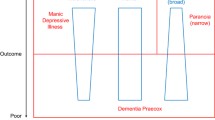Abstract
Kraepelin’s basic attitude to the classification of psychoses was data-oriented and flexible. In his latter years he was close to revising his own celebrated dichotomy between manic-depressive insanity and dementia praecox in order to take account of a large group of intermediate psychoses, which today are called schizo-affective. His concept of a continuum from healthy to ill has stood the test of time and corresponds to modern epidemiological findings. Kraepelin’s unitarian concept of manic-depressive insanity did not survive. It was differentiated and broken down into several subgroups, and a proportional diagnostic spectrum with a continuum from mania via bipolar disorders to depression has recently even been proposed. Bipolar disorders would in that case be comorbid disorders of mania plus depression. In contrast to Kraepelin’s unitarian view the long-term prognosis of subgroups of mood disorders varies considerably. Overall it is nevertheless astonishing how much of Kraepelin’s legacy has survived.
Similar content being viewed by others
References
Angst J (2007) The bipolar spectrum. Br J Psychiatry 190:189–191
Angst J (1978) The course of affective disorders. II. Typology of bipolar manic-depressive illness. Arch Psychiatr Nervenkr 226:65–73
Angst J (2004) Hypomania: definition, assessment, prevalence and clinical significance. In: IX Congresso Nazionale della Società Italiana di Psicopatologia. Rome, p 57–69
Angst J (1966) Zur Ätiologie und Nosologie endogener depressiver Psychosen. Eine genetische, soziologische und klinische Studie. Springer, Berlin
Angst J, Adolfsson R, Benazzi F, Gamma A, Hantouche E, Meyer TD, Skeppar P, Vieta E, Scott J (2005) The HCL-32: towards a self-assessment tool for hypomanic symptoms in outpatients. J Affect Disord 88:217–233
Angst J, Baenninger R, Nuesperli M, Scharfetter C, Stassen HH (1985) Syndromale Gruppierungen endogener Psychosen in genetischer Sicht. In: Pflug B, Foerster K, Straube E (eds) Perspektiven der Schizophrenie-Forschung. Gustav Fischer Verlag, Stuttgart, pp 25–38
Angst J, Gerber-Werder R, Zuberbühler H-U, Gamma A (2004) Is bipolar I disorder heterogeneous? Eur Arch Psychiatry Clin Neurosci 254:82–91
Angst J, Scharfetter C (1990) Schizoaffektive Psychosen—ein nosologisches Ärgernis. In: Lungershausen E, Kaschka WP, Witkowski RJ (eds) Affektive Psychosen. Schattauer, Stuttgart, pp 23–31
Angst J, Scharfetter C, Stassen HH (1983) Classification of schizo-affective patients by multidimensional scaling and cluster-analysis. Psychiatr Clin 16:254–264
Berrios GE (1996) The history of mental symptoms. Descriptive psychopathology since the nineteenth century. Cambridge University Press, Cambridge
Brand S, Luethi M, von Planta A, Hatzinger M, Holsboer-Trachsler E (2007) Romantic love, hypomania, and sleep pattern in adolescents. J Adolesc Health 41:69–76
Dunner DL, Fleiss JL, Fieve RR (1976) The course of development of mania in patients with recurrent depression. Am J Psychiatry 133:905–908
Häfner H, Maurer K, Trendler G, an der Heiden W, Schmidt M, Könnecke R (2005) Schizophrenia and depression: challenging the paradigm of two separate diseases—a controlled study of schizophrenia, depression and healthy controls. Schizophr Res 77:11–24
Hoche P (1912) Die Bedeutung der Symptomenkomplexe in der Psychiatrie. Z Ges Neurol Psychiatr 12:540–551
Kahlbaum K (1863) Die Gruppirung der psychischen Krankheiten und die Eintheilung der Seelenstörungen. A.W. Kafemann, Danzig
Kahlbaum K (1884) Über cyclisches Irresein. Allg Z Psychiatr 40:405–406
Kahlbaum K (1882) Über cyklisches Irresein. Der Irrenfreund 24:145–157
Kessing LV, Hansen MG, Andersen PK, Angst J (2004) The predictive effect of episodes on the risk of recurrence in depressive and bipolar disorders—a life-long perspective. Acta Psychiatr Scand 109:339–344
Kick H (1981) Die Dichotomie der idiopathischen Psychosen im Syndromprofilvergleich der Kraepelinschen Krankheitsbeschreibungen. Nervenarzt 52:522–524
Kolle K (1956) Emil Kraepelin 1856–1926. In: Kolle K (ed) Grosse Nervenärzte. 21 Lebensbilder. Georg Thieme Verlag, Stuttgart, pp 175–186
Kraepelin E (1913) Das manisch-depressive Irresein. In: Psychiatrie. Ein Lehrbuch für Studierende und Ärzte. Barth, Leipzig, pp 1183–1395
Kraepelin E (1915) Die Tätigkeitsneurosen (Ponopathien). In: Psychiatrie. Ein Lehrbuch für Studierende und Ärzte. Verlag Johann Ambrosius Barth, Leipzig, pp 1400–1417
Kraepelin E (1974) Patterns of mental disorder. In: Hirsch SR, Shepherd M (eds) Themes and variations in European psychiatry. An anthology. John Wright & Sons, Bristol, pp 7–30
Kretschmer E (1921) Körperbau und Charakter. Untersuchungen zum Konstitutionsproblem und zur Lehre von den Temperamenten. Springer, Berlin
Marneros A (2006) Beyond the Kraepelinian dichotomy: acute and transient psychotic disorders and the necessity for clinical differentiation. Br J Psychiatry 189:1–2
Marneros A (2006) Continuity between psychosis and bipolarity. Aspects Affect 2:160–164
Marneros A (2007) The paradigm of overlapping affective and schizophrenic spectra: schizoaffective conditions. In: Marneros A, Akiskal HS (eds) The overlap of affective and schizophrenic spectra. Cambridge University Press, Cambridge, pp 1–24
Perris C (1966) A study of bipolar (manic-depressive) and unipolar recurrent depressive psychoses. Acta Psychiatr Scand 42:1–189
Slater E (1938) Zur Periodik des manisch-depressiven Irreseins. Z Ges Neurol Psychiatr 162:794–801
Winokur G, Clayton PJ, Reich T (1969) Manic depressive illness. C.V. Mosby Company, St Louis
Disclosure
The authors have no conflict of interest to declare.
Author information
Authors and Affiliations
Corresponding author
Rights and permissions
About this article
Cite this article
Angst, J., Gamma, A. Diagnosis and course of affective psychoses: was Kraepelin right?. Eur Arch Psychiatry Clin Neurosc 258 (Suppl 2), 107–110 (2008). https://doi.org/10.1007/s00406-008-2013-2
Published:
Issue Date:
DOI: https://doi.org/10.1007/s00406-008-2013-2




